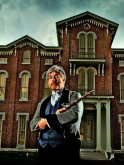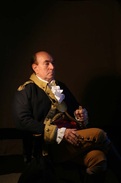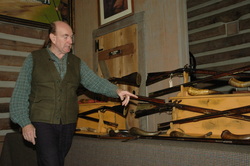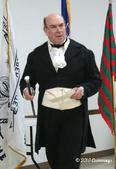Many Faces of Mel Hankla
Cassius Marcellus Clay
Emancipationist
1810-1903
Emancipationist
1810-1903
Cassius Marcellus Clay was the youngest son of General Green Clay and Sally Lewis Clay. Although raised by one of the wealthiest landowners and largest slaveholders in Kentucky, Cassius did not approve of the institution of slavery.
Cassius M. Clay was very well educated for the time, attending both Transylvania University and Yale University, earning a Law degree. It was while he was at Yale that Clay heard the famous abolitionist William Lloyd Garrison speak. Garrison had a great impact on Cassius’ views. Afterwards Clay devoted a great portion of his life to speaking out against the “peculiar institution” and fought for the gradual emancipation of slaves, freeing the slaves that he legally owned in 1844. Clay’s opinions regarding slavery did not meet with much approval; however he did not let widespread opinion deter him. He was the owner and editor of the True American, an antislavery newspaper published in Lexington, Kentucky. Clay encouraged abolitionist John G. Fee to move to Berea, Kentucky and donated to Fee money and a ten-acre tract in Madison County for the beginnings of a school that would become Berea College, the first interracial college in the South. Clay frequently traveled to political rallies speaking out against slavery. At one political rally in Illinois Cassius met Abraham Lincoln and became friends with him. Clay campaigned for Lincoln in 1860, and received the appointment of Minister to Russia when Lincoln took Presidential office. While serving as Ambassador to Russia, Clay was very influential in negotiating the United States’ purchase of Alaska from Russia.
Politically Cassius M. Clay was once a member of the Whig party, but later left and became an ardent supporter of the Republican Party, assisting in the establishment of that party. For a time Clay was also a Democrat to protest the harsh policies of the Grant Administration towards the southern states. Clay served in the General Assembly on three separate occasions and ran unsuccessfully for governor in 1851.
Cassius M. Clay’s military career was impressive; he served honorably as a captain in the Kentucky Militia in the Mexican-American War. Before Clay left for his diplomatic post as Minister to Russia in 1861, he organized a group of volunteers to help defend Washington, D.C. upon the outbreak of the Civil War. His group, called the Clay Battalion, protected the White house until federal troops arrived. Clay also served for a brief time as a Major General in the Civil War.
In his private live Cassius M. Clay married twice. Clay’s first wife was Mary Jane Warfield Clay, to whom he was married to for forty-five years and had ten children with. Cassius’ second marriage was surrounded by scandal, in that Clay was 84 years old when he married while his bride, Dora Richardson, was only 15. This marriage lasted only four years and did not result in any children.
Cassius M. Clay continued to fight for the equal rights of African Americans to the end of his life. Clay passed away on July 22, 1903, and as a testament to his antislavery work, mourners at his death included both the white and African-American population. A contemporary newspaper commented, “Never was a more striking scene witnessed on the way to Richmond, where the funeral services were to be held. From every humble negro cottage along the roadside and at every cross roads, the mothers and large children carrying those who were too little to walk, the negroes were lined up to pay their last respects to the man whom they honored as the Abraham Lincoln of Kentucky.”
Because of his outspokenness against slavery in a pro-slavery area, his willingness to fight for those beliefs, and scandal within his own personal life, Clay had been one of the most controversial Kentuckians of his time; yet, his support of Lincoln and of the Union helped to preserve the United States.
Cassius M. Clay was very well educated for the time, attending both Transylvania University and Yale University, earning a Law degree. It was while he was at Yale that Clay heard the famous abolitionist William Lloyd Garrison speak. Garrison had a great impact on Cassius’ views. Afterwards Clay devoted a great portion of his life to speaking out against the “peculiar institution” and fought for the gradual emancipation of slaves, freeing the slaves that he legally owned in 1844. Clay’s opinions regarding slavery did not meet with much approval; however he did not let widespread opinion deter him. He was the owner and editor of the True American, an antislavery newspaper published in Lexington, Kentucky. Clay encouraged abolitionist John G. Fee to move to Berea, Kentucky and donated to Fee money and a ten-acre tract in Madison County for the beginnings of a school that would become Berea College, the first interracial college in the South. Clay frequently traveled to political rallies speaking out against slavery. At one political rally in Illinois Cassius met Abraham Lincoln and became friends with him. Clay campaigned for Lincoln in 1860, and received the appointment of Minister to Russia when Lincoln took Presidential office. While serving as Ambassador to Russia, Clay was very influential in negotiating the United States’ purchase of Alaska from Russia.
Politically Cassius M. Clay was once a member of the Whig party, but later left and became an ardent supporter of the Republican Party, assisting in the establishment of that party. For a time Clay was also a Democrat to protest the harsh policies of the Grant Administration towards the southern states. Clay served in the General Assembly on three separate occasions and ran unsuccessfully for governor in 1851.
Cassius M. Clay’s military career was impressive; he served honorably as a captain in the Kentucky Militia in the Mexican-American War. Before Clay left for his diplomatic post as Minister to Russia in 1861, he organized a group of volunteers to help defend Washington, D.C. upon the outbreak of the Civil War. His group, called the Clay Battalion, protected the White house until federal troops arrived. Clay also served for a brief time as a Major General in the Civil War.
In his private live Cassius M. Clay married twice. Clay’s first wife was Mary Jane Warfield Clay, to whom he was married to for forty-five years and had ten children with. Cassius’ second marriage was surrounded by scandal, in that Clay was 84 years old when he married while his bride, Dora Richardson, was only 15. This marriage lasted only four years and did not result in any children.
Cassius M. Clay continued to fight for the equal rights of African Americans to the end of his life. Clay passed away on July 22, 1903, and as a testament to his antislavery work, mourners at his death included both the white and African-American population. A contemporary newspaper commented, “Never was a more striking scene witnessed on the way to Richmond, where the funeral services were to be held. From every humble negro cottage along the roadside and at every cross roads, the mothers and large children carrying those who were too little to walk, the negroes were lined up to pay their last respects to the man whom they honored as the Abraham Lincoln of Kentucky.”
Because of his outspokenness against slavery in a pro-slavery area, his willingness to fight for those beliefs, and scandal within his own personal life, Clay had been one of the most controversial Kentuckians of his time; yet, his support of Lincoln and of the Union helped to preserve the United States.




